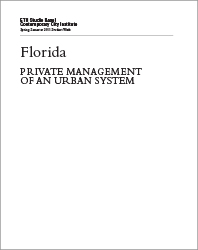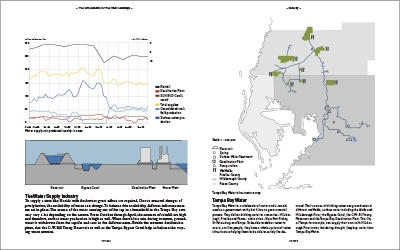Florida - Private Management of an Urban System

Professors: Roger Diener, Marcel Meili
Assistants: Mathias Gunz, Rolf Jenni, Milica Topalovic, Christian Müller Inderbitzin
University of Florida – School of Architecture: Prof. Donna L. Cohen, Prof. Nancy M. Clark; students: Jared Akers, Ali Can Atabey, Laura P. Badraun, Alyssa N. Costas, Jessica L. Cruze, Brittany M. Dexter, Jack Easton Haller, Victoria Janok, Yadira Jerez, Raquel Suzane Kalil, Andresa P. Maia, Andrea McCain, Davie Mojica, Samantha Jo Nalbach, Madeline Sewall, Andrea Smith, Rommy E. Torrico, Randall A. Yarborough
Special thanks to our friends and collaborators: Phil Laurien and the East Central Florida Planning Council; Pat Steed and the Central Florida Regional Planning Council; Luc Burkhardt, Honorary Consul of Switzerland, Orlando; Beat Kähli, Avalon Park Associates, Orlando; Michael Chanen, Reclamation Supervisor, The Mosaic Company; Mark Sees, Orlando Wetlands Park; Jon Ippel, Holly B. Stenger, Christine Kefauver; City of Orlando; Robert McLeod and the University of Southern Florida, TampaGraphic Designer: Absolut Agentur, St. Gallen
Editorial Supervisors: Mathias Gunz, Vesna Jovanovic
Editorial Assistant: Stephanie Winter, Davie Mojica
Druckerei Weber GmbH & Co., Lörrach.
Published by ETH Studio Basel: Contemporary City Institute, Basel 2015

Florida’s urbanization is still young – in most cases only a primary layer. This is not least due to its specific natural condition, whose instability (swamps, heavy rain, periodic floods) made it for long impossible to domesticate. Only through technical systems such as air-conditioning, water-management and the highway network could its complex natural balance be transferred into a new, equally complex artificial balance – but then very fast and comprehensively. Florida’s urbanization thus had from its beginning a territorial dimension and character. Road infrastructure, real-estate speculation, mining operations, agriculture, wetlands and all other functions in the territory form a tightly interlinked system; each, and this includes even nature protection, measured and treated based on its performance for the system. This managerial approach creates unexpected links between the urban centers and their territory such as mitigation banking, where through a free market mechanic the externalities of building in the city are redeemed in faraway parks. Seemingly untouched wilderness reveals to be depending on the most artificial environments, such as the Disney parks or the highly simulated lifestyle communities, and vice versa. This project continues ETH Studio Basel’s series of territorial investigations and is based on fieldwork that was conducted in Central Florida in collaboration with the University of Florida.

